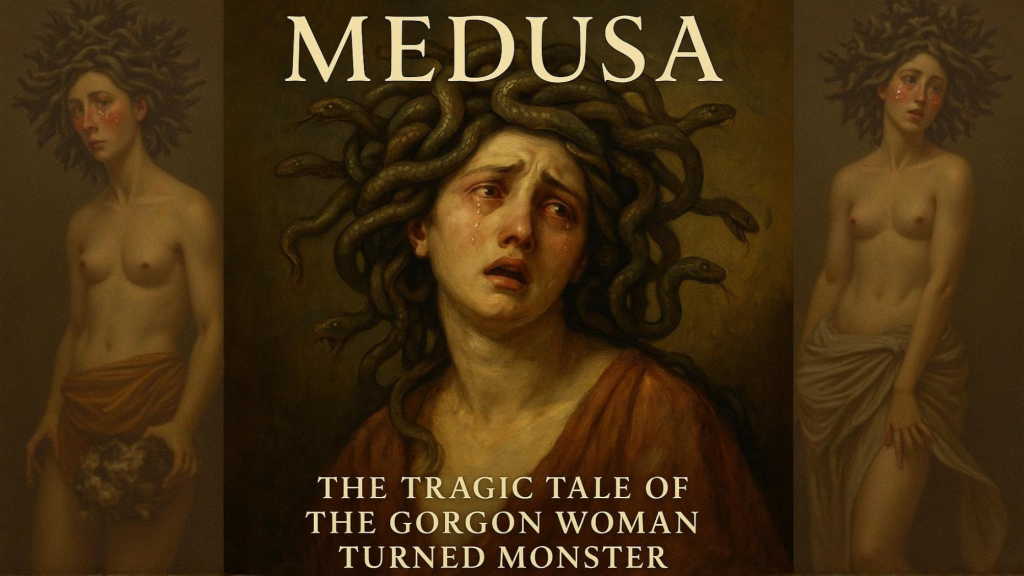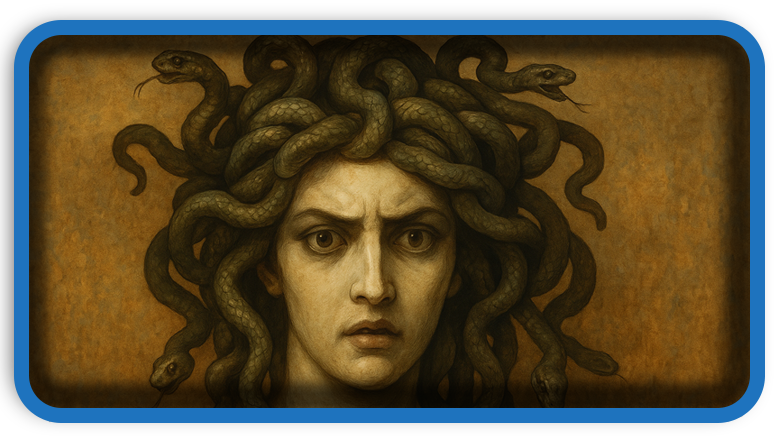⏲️ Estimated reading time: 5 min
Medusa: The Tragic Tale of the Gorgon Woman Turned Monster. Medusa’s story is one of ancient mythology’s most misunderstood. Once a beautiful maiden, she became a feared monster with snakes for hair. Discover her full transformation, the curse, and how she met her end in this gripping Greek legend.
The Story of Medusa
Gorgon
In Greek mythology, Medusa is one of the most famous and fearsome creatures ever described. Known as one of the three Gorgon sisters Stheno, Euryale, and Medusa she was the only one who was mortal. While her sisters were born monsters, Medusa was once a beautiful maiden, with golden hair, a gentle smile, and radiant charm that caught the attention of both mortals and gods alike.
Medusa: The Beautiful Priestess
Before becoming a monster, Medusa served as a priestess in the temple of Athena, the virgin goddess of wisdom and war. As a priestess, she was sworn to a life of chastity and devotion. But her beauty was so extraordinary that it eventually led to her tragic downfall.

The Violation in Athena’s Temple
According to the Roman poet Ovid’s Metamorphoses, the god Poseidon (Neptune) desired Medusa and assaulted her in Athena’s sacred temple. This act of desecration enraged the goddess not at Poseidon, but at Medusa. In a display of divine fury and punishment, Athena transformed Medusa’s beautiful hair into a crown of venomous snakes and made her face so terrifying that anyone who looked directly at her would be turned to stone.
Transformation Into a Monster
With her curse, Medusa became a creature of horror. No longer revered, she was exiled to live at the edge of the world. Her image often depicted with bulging eyes, a lolling tongue, and coiled serpents for hair became synonymous with death and fear. Yet beneath the terrifying visage was a woman who had suffered unjust punishment.
Perseus and the Slaying of Medusa
Years later, the hero Perseus was sent on a dangerous quest by King Polydectes to bring back the head of Medusa. This was meant to be a suicide mission. However, Perseus received divine help: Athena gave him a polished shield, Hermes offered winged sandals, and Hades provided a helmet of invisibility.
Perseus approached Medusa while she slept, using the reflective shield to avoid her petrifying gaze. With a swift stroke of his sword, he beheaded her. From her severed neck sprang Pegasus, the winged horse, and Chrysaor, a golden warrior both children of Poseidon.

The Power of Medusa’s Head
Even in death, Medusa’s head retained its power. Perseus used it as a weapon to turn his enemies to stone, including the tyrant Polydectes. Eventually, he gave the head to Athena, who placed it on her shield, the Aegis, as a symbol of protection and power.
Medusa as a Symbol
Over time, the image of Medusa evolved. While ancient Greeks feared her as a monster, later generations began to see her differently. Feminist interpretations reframe her story as one of victimization and survival. Medusa became a symbol of feminine rage, trauma, and empowerment.
Her face has been adopted by fashion designers, sculptors, and writers as an emblem of beauty, power, and rebellion. The Medusa head even became the logo of the Italian luxury brand Versace, representing strength and seduction.
Artistic Representations Through the Ages
From classical statues to Renaissance paintings, Medusa has fascinated artists for centuries. Caravaggio’s famous painting shows the severed head in mid-expression, eyes wide with pain and terror. Sculptures often show her as a mix of beauty and beast, reinforcing the tragic contradiction of her existence.
Even modern films and books feature Medusa as a monster to be defeated or a misunderstood figure. Her myth endures because it speaks to themes of transformation, injustice, revenge, and identity.
Reflecting on Medusa’s Legacy
Medusa’s story is not just about horror it’s about misunderstanding, abuse of power, and transformation. She is not merely a villain of mythology but also a symbol of how women’s voices and pain were historically ignored or punished. Her myth is a reminder of the complexity of ancient stories and how their meanings evolve over time.
🔔 For more tutorials like this, consider subscribing to our blog.
📩 Do you have questions or suggestions? Leave a comment or contact us!
🏷️ Tags: Medusa, Greek mythology, Perseus, Athena, Gorgons, Pegasus, ancient Greece, mythological creatures, legends, Ovid
📢 Hashtags: #Medusa #GreekMythology #Perseus #Athena #MythicalCreatures #Gorgon #AncientLegends #Ovid #MythologyExplained #LegendaryWomen
Final Reflections
The myth of Medusa reminds us that stories are rarely black and white. Behind every monster, there may be a victim. Medusa, once a beautiful and devout woman, was cursed into monstrosity not by her actions, but by the injustice of the gods. Her legacy today challenges us to re-examine power, gender, and the stories we choose to tell.
Only logged-in users can submit reports.
Discover more from HelpZone
Subscribe to get the latest posts sent to your email.

